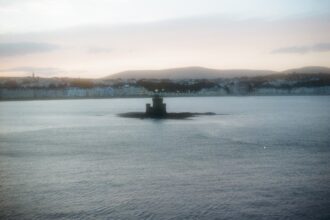Operation Paperclip emerged in the aftermath of World War II, a time when the United States found itself in a race against the Soviet Union for technological supremacy.
The U.S. government initiated Operation Paperclip to recruit these individuals, believing that their expertise could be pivotal in advancing American military technology and securing national interests during the burgeoning Cold War. The operation was shrouded in secrecy and controversy from its inception. Many of the scientists targeted for recruitment had been involved in projects that supported the Nazi regime, raising ethical questions about the morality of employing former enemies. Despite these concerns, the urgency of the Cold War and the desire to outpace Soviet advancements led to a pragmatic approach. The U.S. government prioritized technological gain over moral considerations, setting the stage for a complex relationship between former adversaries and their new American benefactors.
Key Takeaways
- Operation Paperclip began as a secret program by the United States to recruit German scientists after World War II.
- The recruitment of German scientists led to significant advancements in naval technology, including submarine technology, radar and sonar systems, aircraft carrier design, missile and rocket technology, and naval weaponry.
- Operation Paperclip had a profound impact on naval technology, leading to the development of more advanced submarines with improved capabilities for underwater warfare.
- The program also contributed to the development of radar and sonar systems, which greatly enhanced the Navy’s ability to detect and track enemy vessels.
- Operation Paperclip’s influence on Cold War naval strategy and its legacy in modern naval technology continue to be subjects of ethical controversy due to the involvement of former Nazi scientists.
The Recruitment of German Scientists
The recruitment process for Operation Paperclip was both systematic and opportunistic. American intelligence agencies, particularly the Office of Strategic Services (OSS) and later the Central Intelligence Agency (CIA), identified key figures in various scientific fields, including aeronautics, rocketry, and medicine.
Among the most notable figures recruited was Wernher von Braun, a leading rocket scientist who had played a crucial role in developing the V-2 rocket for Germany. His expertise would later prove invaluable in advancing U.S. space exploration efforts.
The recruitment of such high-profile scientists not only bolstered American technological capabilities but also sent a clear message to the world about the U.S.’s commitment to harnessing advanced science for its strategic advantage.
The Impact of Operation Paperclip on Naval Technology

Operation Paperclip had a profound impact on naval technology, as many of the recruited scientists brought with them knowledge and experience that would shape the future of naval warfare. The integration of German expertise into American military research and development programs led to significant advancements in various areas, including submarine technology, radar systems, and missile development. This influx of talent allowed the U.S.
Navy to modernize its fleet and enhance its operational capabilities during a critical period in history. The influence of these German scientists extended beyond mere technological improvements; it also fostered a culture of innovation within the U.S. military establishment.
Their methodologies and approaches to problem-solving encouraged American engineers and researchers to think outside traditional paradigms, leading to breakthroughs that would define naval operations for decades to come. The collaboration between former adversaries ultimately transformed the landscape of naval warfare, setting new standards for efficiency and effectiveness.
Advancements in Submarine Technology
| Advancement | Description |
|---|---|
| Improved Stealth | New materials and designs have enhanced submarines’ ability to evade detection. |
| Enhanced Maneuverability | New propulsion systems and control mechanisms have improved submarines’ agility underwater. |
| Increased Endurance | Better energy storage and management technologies have extended submarines’ operational range. |
| Advanced Sensors | New sensor technologies have improved submarines’ ability to detect and track targets. |
| Improved Communication | Enhanced communication systems have allowed submarines to stay connected while submerged. |
One of the most significant contributions from Operation Paperclip was in the realm of submarine technology. German engineers had developed advanced submarine designs during World War II, particularly with their U-boats, which were known for their stealth and effectiveness in naval combat. The knowledge gained from these designs was instrumental in shaping the U.S.
Navy’s approach to submarine warfare in the post-war era. The integration of German expertise led to innovations such as improved hull designs, advanced propulsion systems, and enhanced stealth capabilities. These advancements allowed American submarines to operate more effectively in various environments, making them formidable assets during the Cold War.
The emphasis on stealth and underwater capabilities became a cornerstone of U.S. naval strategy, enabling submarines to conduct covert operations and gather intelligence without detection.
Developments in Radar and Sonar Systems
In addition to submarine technology, Operation Paperclip significantly advanced radar and sonar systems used by the U.S. Navy. German scientists had made substantial progress in these fields during the war, developing technologies that could detect enemy vessels and aircraft with greater accuracy.
By incorporating this knowledge into American systems, the Navy was able to enhance its situational awareness and improve its defensive capabilities. The advancements in radar technology allowed for better tracking of enemy movements, while improvements in sonar systems enabled submarines to detect threats underwater more effectively. These developments not only increased the Navy’s operational efficiency but also played a crucial role in ensuring maritime security during a time of heightened tensions with the Soviet Union.
The ability to detect and respond to potential threats became a defining characteristic of U.S. naval strategy throughout the Cold War.
Contributions to Aircraft Carrier Design

Operation Paperclip also had a lasting impact on aircraft carrier design, an essential component of naval power projection. German engineers brought innovative ideas regarding aircraft launch systems, flight deck configurations, and overall carrier design that would influence American naval architecture for years to come. Their insights into maximizing efficiency and operational effectiveness were integrated into new carrier designs that would serve as platforms for air superiority.
The introduction of concepts such as angled flight decks and steam catapults revolutionized how aircraft carriers operated, allowing for simultaneous takeoffs and landings while maximizing available space on deck. These advancements not only improved operational capabilities but also enhanced the safety of carrier operations, reducing the risk of accidents during flight operations. As a result, U.S.
aircraft carriers became more versatile and powerful tools for projecting military force around the globe.
Innovations in Missile and Rocket Technology
The contributions of German scientists to missile and rocket technology were perhaps some of the most transformative outcomes of Operation Paperclip. Wernher von Braun’s work on rocket propulsion laid the groundwork for America’s space program and military missile systems. His expertise facilitated significant advancements in ballistic missile technology, which became crucial during the Cold War as nations sought to develop reliable delivery systems for nuclear weapons.
The integration of German rocket technology into American military programs led to the development of various missile systems that enhanced deterrence capabilities. The U.S. Navy’s Polaris missile program, which provided submarines with nuclear strike capabilities, was directly influenced by German innovations in rocketry.
This shift not only changed naval warfare but also altered global power dynamics as countries raced to develop their own missile technologies.
Enhancements in Naval Weaponry
Operation Paperclip also contributed to enhancements in naval weaponry beyond missiles and rockets. The influx of German expertise led to improvements in various armaments used by the U.S. Navy, including torpedoes, anti-aircraft systems, and naval guns.
These advancements were critical in ensuring that American naval forces remained competitive against potential adversaries during a time when military technology was rapidly evolving. The incorporation of advanced targeting systems and guidance technologies into naval weaponry allowed for greater accuracy and effectiveness in combat scenarios. As a result, U.S.
naval forces were better equipped to engage enemy vessels and aircraft with precision strikes, minimizing collateral damage while maximizing operational success. This evolution in naval weaponry underscored the importance of technological superiority in maintaining maritime dominance.
The Influence of Operation Paperclip on Cold War Naval Strategy
The influence of Operation Paperclip extended beyond technological advancements; it fundamentally shaped U.S. naval strategy during the Cold War. The integration of German scientists into American military programs allowed for a more sophisticated understanding of naval warfare dynamics, leading to strategies that emphasized deterrence, rapid response capabilities, and technological superiority.
As tensions escalated between the United States and the Soviet Union, the Navy adopted strategies that leveraged its advanced technologies developed through Operation Paperclip. The emphasis on submarine warfare, missile capabilities, and air superiority became central tenets of U.S. naval doctrine, allowing for a flexible response to potential threats across various theaters of conflict.
This strategic evolution was instrumental in maintaining a balance of power during a period marked by uncertainty and rivalry.
The Legacy of Operation Paperclip in Modern Naval Technology
The legacy of Operation Paperclip continues to resonate within modern naval technology and strategy. Many advancements made possible by German scientists have become foundational elements of contemporary naval operations. The principles established during this period laid the groundwork for ongoing research and development efforts aimed at maintaining technological superiority in an increasingly complex global landscape.
Today’s naval forces benefit from innovations that trace their roots back to Operation Paperclip, including advanced missile systems, stealth technologies, and sophisticated surveillance capabilities. As nations continue to invest in maritime power projection, the lessons learned from this operation remain relevant in shaping future naval strategies and technologies.
Ethical Controversies Surrounding Operation Paperclip
Despite its significant contributions to American military technology, Operation Paperclip has been mired in ethical controversies since its inception. Critics argue that recruiting scientists who had previously worked for a regime responsible for heinous war crimes raises profound moral questions about complicity and accountability. The decision to prioritize technological advancement over ethical considerations has sparked debates about the implications of such actions on international relations and human rights.
Furthermore, the secrecy surrounding Operation Paperclip has fueled suspicions about government transparency and accountability. Many individuals remain concerned about how historical narratives are shaped by selective memory regarding wartime actions and post-war decisions. As historians continue to examine this complex chapter in history, it becomes increasingly clear that Operation Paperclip serves as both a testament to human ingenuity and a cautionary tale about the ethical dilemmas inherent in wartime decisions.
Operation Paperclip was a secret program initiated by the United States after World War II, aimed at recruiting German scientists, engineers, and technicians, many of whom had been involved in Nazi projects, to work for the U.S. government. This operation significantly impacted various fields, including naval technology, as these experts brought advanced knowledge and innovations that were integrated into American military advancements. For a deeper understanding of the implications and historical context of Operation Paperclip, you can explore a related article on this topic by visiting In The War Room. This resource provides insights into how these technological transfers influenced post-war military strategies and developments.
WATCH THIS! America’s Nuclear Navy Was Born From Espionage
FAQs
What is Operation Paperclip?
Operation Paperclip was a secret program of the United States government in which more than 1,600 German scientists, engineers, and technicians, including many from the Nazi Party, were brought to the United States after World War II to work on various projects, including naval technology.
What was the goal of Operation Paperclip?
The goal of Operation Paperclip was to gain the scientific and technological expertise of German scientists, particularly in the fields of rocketry, aeronautics, and naval technology, in order to gain an advantage in the Cold War against the Soviet Union.
How did Operation Paperclip impact naval technology?
Operation Paperclip had a significant impact on naval technology, as many of the German scientists and engineers brought to the United States had expertise in areas such as submarine design, sonar technology, and missile development. Their knowledge and expertise contributed to advancements in US naval technology during the Cold War.
What were some specific contributions of Operation Paperclip to naval technology?
Some specific contributions of Operation Paperclip to naval technology included advancements in submarine design, the development of new sonar and radar systems, and the improvement of missile technology for naval warfare.
Were there any ethical concerns surrounding Operation Paperclip?
Yes, there were ethical concerns surrounding Operation Paperclip, as many of the German scientists and engineers brought to the United States had been members of the Nazi Party and had been involved in war crimes during World War II. This raised questions about the morality of recruiting and employing these individuals, despite their scientific expertise.




